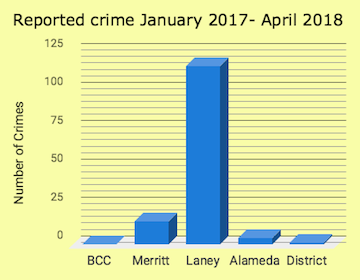Laney’s crime rate far surpasses that of the other Peralta colleges
by Eva Hannan


Of all reported crimes at Peralta Colleges, 85 percent occur at Laney College, according to the Peralta Police Services crime log.
Between Jan. 1, 2017 and April 13, 2018, a total of 136 crimes were reported to the Peralta Police Services (PPS). Of the reported crimes, 116 were on the Laney campus and 15 at Merritt College. The remaining reports came from the College of Alameda campus and the district offices. There were no reported crimes from Berkeley City College in the crime log during this time.
But BCC’s apparent lack of crime was called into question on May 10 when the San Francisco Chronicle reported that a 2016 stalking and rape reported to Berkeley City Police was not properly disclosed by the college.
The Clery Act requires any college or university that participates in federal financial aid programs to publish easily accessible reports of the rate of serious or violent crimes as they occur on campus. These include “grand theft, homicide, manslaughter, rape, sexual assault, domestic violence, incest, hate crimes, arson, and any arrests,” said Don Lawson, head of security at BCC since 2017.
Yearly reports about these crimes are posted on each school’s website. PPS also keeps a crime log, which tracks other minor crimes that occur. It is available for public viewing at the PPS command center, which is located at the Peralta District Office, 333 8th St. in Oakland.
PPS Sergeant Rene Basilio attributes Laney’s dramatically higher crime rate to layout and location. The open campus and proximity to the Lake Merritt BART Station and downtown Oakland means Laney has a lot of foot traffic. “The Laney campus is a thoroughfare,” he said. “People that have no affiliation with the school use it to get from point A to point B.”
While both College of Alameda and Merritt College boast similarly open layouts, neither are accessible by BART. BCC is close to BART, but the campus is contained in a six-story building in downtown Berkeley, with a single public entrance staffed by Securitas Securities System 16 hours per day.
Securitas also monitors the other Peralta campuses between 11 p.m. and 7 a.m. All other hours are monitored by the 15-person PPS staff, which is on contract with the district from the Alameda County Sheriff’s Department.
Of the crimes reported at Laney, 51 percent are related to theft. Cell phones, laptop computers, and cash are the most commonly stolen items on campus, said Amy Marshall, Laney’s interim supervisor for business and administrative services.

All victims of theft are encouraged to file police reports, she said. “We are pretty progressive about making sure people are reporting… even if there is no result,” she said.
Despite this policy, not all crimes that occur on the Laney campus are reported. “A lot of the domestic violence calls are unreported because [the victim’s] significant other is involved,” Basilio said.
Reports of assault, robbery, battery, and fights are uncommon at any of the Peralta campuses — a total of five were reported during this period, the Tower has documented.
Students tend to file a report if they feel threatened by a stranger, Sgt. Basilio said, but administrative staff and faculty are far less likely to do so.
When someone does file a report, Laney has 143 video cameras on campus to help identify suspects, provide evidence, and record license plate numbers. Currently, six of the cameras are not in service, PPS Lieutenant Verbeck said.
Many of the working cameras were blocked by trees until the district hired the grounds crew to trim the branches in March, which was cause for alarm among some Laney instructors (see April 19 issue of the Laney Tower). “All we could see in those cameras were leaves and sticks,” Sgt. Basilio said.
Some of the cameras transmit over outdated wireless internet that is not sufficient to support all of the information, so the transmissions can get interrupted. “It’s day-to-day,” Sgt. Basilio said. “A new antenna has been ordered, so they’re working on it.”
According to Lawson, all of BCC’s cameras are operational and the rate of incidents to report is not very high.
Peralta’s Vice Chancellor of General Services, Dr. Sadiq Ikharo, said there is no area of the campus completely without surveillance.
“The number of cameras that are down are not sufficient to pose risks [to students],” he said. Ikharo pointed out that the district is also increasing security at Laney by installing locks on the doors that use computerized magnetic key fobs.
The fobs will replace keys, which Sgt. Basilio said have become a liability on campus.
“Keys have been lost or stolen,” he said. “We arrested a homeless person, not too long ago, who would let herself in at night and sleep in the classrooms. She admitted to us that other people in her encampment have keys as well.”
Laney Public Information Officer Dolores Bernal said the switch to fobs should also help alleviate some the vandalism that occurs regularly to the 800-plus doors on campus. The programmable locks will alert PPS to any attempted break-ins with a “tamper alert” and “door-ajar alarm,” she said.
Ikharo said the switchover to the key fobs started in April and will be completed within five months.
PPS publishes a brochure entitled “Personal Safety on Campus” that encourages students to make note of any suspicious activity and to be “aware of their surroundings… Reporting suspicious individuals and activities … often prevents a crime from occurring. Do not take chances!” it reads.
Eva Hannan is a staff writer at the Laney Tower.

























